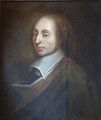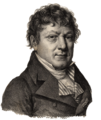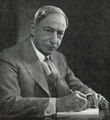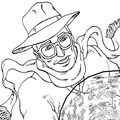Template:Selected anniversaries/August 19: Difference between revisions
No edit summary |
No edit summary |
||
| Line 8: | Line 8: | ||
File:Blaise Pascal.jpg|link=Blaise Pascal (nonfiction)|1662: Mathematician, physicist, inventor, writer, and Christian philosopher [[Blaise Pascal (nonfiction)|Blaise Pascal]] dies. He did pioneering work on calculating machines. | File:Blaise Pascal.jpg|link=Blaise Pascal (nonfiction)|1662: Mathematician, physicist, inventor, writer, and Christian philosopher [[Blaise Pascal (nonfiction)|Blaise Pascal]] dies. He did pioneering work on calculating machines. | ||
||1692 | ||1692: Salem witch trials: In Salem, Province of Massachusetts Bay, five people, one woman and four men, including a clergyman, are executed after being convicted of witchcraft. | ||
||Erland Samuel Bring | ||1736: Erland Samuel Bring born ... mathematician. | ||
||Johan Gottlieb Gahn | ||1745: Johan Gottlieb Gahn born ... chemist and metallurgist who discovered manganese in 1774. Pic. | ||
||1753 | ||1753: Johann Balthasar Neumann dies ... engineer and architect, designed Basilica of the Fourteen Holy Helpers. | ||
File:Jean-Étienne Montucla.jpg|link=Jean-Étienne Montucla (nonfiction)|1758: [[Jean-Étienne Montucla (nonfiction)|Jean-Étienne Montucla]] received the censor's approbation for his ''Histoire des mathematiques'', which is justly famous as a history of the mathematical sciences. | File:Jean-Étienne Montucla.jpg|link=Jean-Étienne Montucla (nonfiction)|1758: [[Jean-Étienne Montucla (nonfiction)|Jean-Étienne Montucla]] received the censor's approbation for his ''Histoire des mathematiques'', which is justly famous as a history of the mathematical sciences. | ||
| Line 58: | Line 58: | ||
File:Philo T Farnsworth.jpg|link=Philo Farnsworth (nonfiction)|1906: Inventor [[Philo Farnsworth (nonfiction)|Philo Farnsworth]] born. He will make many crucial contributions to the early development of all-electronic television. | File:Philo T Farnsworth.jpg|link=Philo Farnsworth (nonfiction)|1906: Inventor [[Philo Farnsworth (nonfiction)|Philo Farnsworth]] born. He will make many crucial contributions to the early development of all-electronic television. | ||
||Joseph Gilbert Hoffman born ... physicist and biophysicist who brought atomic isotopes into the battle against cancer. During WW II, he developed a radio proximity fuse and later was a health-physics scientist with "Manhattan Project." Hoffman studied nine accident victims of radiation disease at Los Alamos in Aug 1945 and May 1946. This research revealed for the first time that atoms of living human tissue could be transformed into radioactive atoms. He recognized "a completely new approach to studying the metabolism of atoms in living tissue and a new way of probing the complicated system of gene cells that determine heredity," and such knowledge was indispensable to understanding the mysteries of cancer research in which he engaged for the rest of his life. Pic: https://www.todayinsci.com/8/8_19.htm | ||1909: Joseph Gilbert Hoffman born ... physicist and biophysicist who brought atomic isotopes into the battle against cancer. During WW II, he developed a radio proximity fuse and later was a health-physics scientist with "Manhattan Project." Hoffman studied nine accident victims of radiation disease at Los Alamos in Aug 1945 and May 1946. This research revealed for the first time that atoms of living human tissue could be transformed into radioactive atoms. He recognized "a completely new approach to studying the metabolism of atoms in living tissue and a new way of probing the complicated system of gene cells that determine heredity," and such knowledge was indispensable to understanding the mysteries of cancer research in which he engaged for the rest of his life. Pic: https://www.todayinsci.com/8/8_19.htm | ||
||1913: Johann Argyris born ... pioneer of computer applications in science and engineering, among the creators of the finite element method (FEM). Pic. | |||
File:Vilfredo Pareto 1870s.jpg|link=Vilfredo Pareto (nonfiction)|1923: Engineer, sociologist, economist, political scientist, and philosopher [[Vilfredo Pareto (nonfiction)|Vilfredo Pareto]] dies. He applied mathematics to economic analysis, asserting that the distribution of incomes and wealth in society is not random and that a consistent pattern appears throughout history, in all parts of the world and in all societies. | File:Vilfredo Pareto 1870s.jpg|link=Vilfredo Pareto (nonfiction)|1923: Engineer, sociologist, economist, political scientist, and philosopher [[Vilfredo Pareto (nonfiction)|Vilfredo Pareto]] dies. He applied mathematics to economic analysis, asserting that the distribution of incomes and wealth in society is not random and that a consistent pattern appears throughout history, in all parts of the world and in all societies. | ||
| Line 80: | Line 82: | ||
||1953: The CIA and MI6 help to overthrow the government of Mohammad Mosaddegh in Iran and reinstate the Shah Mohammad Reza Pahlavi. | ||1953: The CIA and MI6 help to overthrow the government of Mohammad Mosaddegh in Iran and reinstate the Shah Mohammad Reza Pahlavi. | ||
||Carl-Gustaf Rossby dies ... meteorologist who first explained the large-scale motions of the atmosphere in terms of fluid mechanics. His work contributed to developing meteorology as a science. Rossby first theorized about the existence of the jet stream in 1939, and that it governs the easterly movement of most weather. U.S. Army Air Corps pilots flying B-29 bombing missions across the Pacific Ocean during World War II proved the jet stream's existence. The pilots found that when they flew from east to west, they experienced slower arrival times and fuel shortage problems. When flying from west to east, however, they found the opposite to be true. Rossby created mathematical models (Rossby equations) for computerized weather prediction (1950). Pic. | ||1957: Carl-Gustaf Rossby dies ... meteorologist who first explained the large-scale motions of the atmosphere in terms of fluid mechanics. His work contributed to developing meteorology as a science. Rossby first theorized about the existence of the jet stream in 1939, and that it governs the easterly movement of most weather. U.S. Army Air Corps pilots flying B-29 bombing missions across the Pacific Ocean during World War II proved the jet stream's existence. The pilots found that when they flew from east to west, they experienced slower arrival times and fuel shortage problems. When flying from west to east, however, they found the opposite to be true. Rossby created mathematical models (Rossby equations) for computerized weather prediction (1950). Pic. | ||
||1960: In Moscow, Russia, Soviet Union, downed American U-2 pilot Francis Gary Powers is sentenced to ten years imprisonment by the Soviet Union for espionage. | ||1960: In Moscow, Russia, Soviet Union, downed American U-2 pilot Francis Gary Powers is sentenced to ten years imprisonment by the Soviet Union for espionage. | ||
Revision as of 14:52, 27 February 2019
1662: Mathematician, physicist, inventor, writer, and Christian philosopher Blaise Pascal dies. He did pioneering work on calculating machines.
1758: Jean-Étienne Montucla received the censor's approbation for his Histoire des mathematiques, which is justly famous as a history of the mathematical sciences.
1822: Mathematician and astronomer Jean Baptiste Joseph Delambre dies. He was one of the first astronomers to derive astronomical equations from analytical formulas.
1823: Red Eyes Fighting depicts martial artist and crime-fighter Red Eyes breaking up a math lab.
1906: Inventor Philo Farnsworth born. He will make many crucial contributions to the early development of all-electronic television.
1923: Engineer, sociologist, economist, political scientist, and philosopher Vilfredo Pareto dies. He applied mathematics to economic analysis, asserting that the distribution of incomes and wealth in society is not random and that a consistent pattern appears throughout history, in all parts of the world and in all societies.
1967: Inventor, writer, editor, and publisher Hugo Gernsback dies. He published the first science fiction magazine, and had a profound influence on the development of science fiction.
1993: Actor-cryptographer Niles Cartouchian confirms that he personally designed the computational security protocols featured in the action-adventure film Dard Hunter, Glyph Warden.
1994: Chemist, biochemist, peace activist, author, and educator Linus Pauling dies.
2015: A giant red ball breaks loose from an art installation and rolls down the street in Toledo, Ohio.
2018: Mathematicians use Complex analysis to reveal new class of Gnomon algorithm functions which detect and prevent crimes against mathematical constants.










